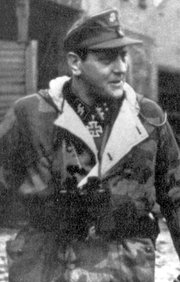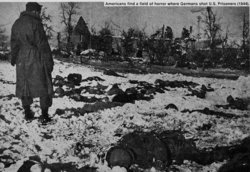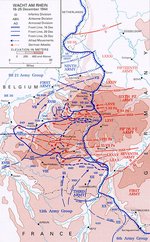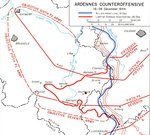Battle of the Bulge
|
|
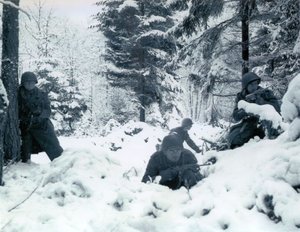
| |||||||||||||||||
| The Battle of the Bulge | |||||||||||||||||
|---|---|---|---|---|---|---|---|---|---|---|---|---|---|---|---|---|---|
| Conflict | World War II | ||||||||||||||||
| Date | December 16, 1944 – January 28, 1945 | ||||||||||||||||
| Place | The Ardennes | ||||||||||||||||
| Result | Allied victory | ||||||||||||||||
| |||||||||||||||||
The German Ardennes Offensive1, popularly known as the Battle of the Bulge, started in late December 1944 and was the last major German offensive on the Western Front during World War II. The German army had intended to split the Allied line in half, capturing Antwerp and then proceeding to sweep north to encircle and destroy four Allied armies, thus as Hitler believed, forcing the Western Allies to negotiate a peace treaty in the Axis' favor.
Although ultimately unsuccessful, the offensive nevertheless tied down huge amounts of Allied resources, and the slow response of the Allies to the resulting gap in their lines erased months from their timetable. However, the offensive also allowed the Allies to severely deplete the cream of the German army outside the defenses of the Siegfried Line and left Germany's remaining forces in a poor state of supply, thus greatly easing the assault on Germany afterward. In numerical terms, it is the largest battle the United States Army has fought to date.
| Contents |
Background
Leadup
The breakout from Normandy in August, 1944 saw the Allies dash across France at unprecedented speeds. Doing so presented enormous logistical problems, as their only deep-water port was at Cherbourg near the original invasion beaches. Although additional port towns had been captured since the invasion, the Germans were careful to wreck them thoroughly to deny their use. Adding to the problem was the near-complete destruction of the French railroad system prior to D-Day, intended to deny movement to the Germans, but now proving equally damaging to the Allies. Instead a massive trucking system known as the Red Ball Express had been set up, but by the time it reached the Belgian border it had burned five gallons of fuel for every one it delivered. Although the German forces continued to stream rearward, by early October the supply situation was so poor that the Allied armies were unable to make much headway.
Each of the Allied generals pressed for all of the supplies to be given to his own army, in order to bring at least a single army to full supply for an offensive. Eisenhower, however, maintained the position of a broad-front strategy, though with priority for Northern forces since their short term goal included opening the urgently needed port Antwerp and their long term goal was the capture of the Ruhr area, the industrial heart of Germany. With the Allies regrouping for supplies the front quieted down, allowing Gerd von Rundstedt to reorganize the remaining German units into a small but somewhat effective defensive force.
Bernard Montgomery's Operation Market Garden, an offense designed to open Antwerp, cross the Rhine and bypass the Siegfried Line was unsuccessful in October, and left the allies in little better position than before. In November the Canadian First Army did get enough supplies to move forward, clearing the Westerschelde by taking Walcheren and opening the huge ports of Antwerp to shipping. It is arguable that this action was considerably more important than Market-Garden, but the Canadian forces had little "pull" compared to Montgomery and George Patton. By the end of the month the supply situation was easing, although allied forces were still spread all over France, Belgium and Luxembourg.
The situation for the Germans was dire. Earlier in the summer Operation Bagration—a massive Soviet offensive on the Eastern Front—burnt itself out in eastern Poland in what the Germans referred to as The Destruction of Army Group Center. Soviet progress was so fast that the offensive only ended due to supply issues and fatigue. Now, several months later, it was clear the Soviet forces were preparing for a winter offensive, likely in December.
Meanwhile the Allied air offensive of early 1944 had effectively grounded the Luftwaffe, leaving them with little battlefield intelligence and no way to interdict Allied supplies. The converse was equally damaging; daytime movement of forces was almost instantly noticed, and interdiction of supplies combined with the bombing of the Romanian oilfields starved Germany of oil and gasoline.
The only "upside" for the German forces at the time was that they were no longer defending all of western Europe. The front lines in the west were considerably shorter and closer to the German heartland, dramatically improving their supply problems regardless of the Allied air control. Additionally, their extensive telephone and telegraph network meant that radios no longer had to be used for communications, which deprived the Allies of their most powerful weapon, Ultra intercepts.
With the end of Bagration and the Canadian advance, fighting eased as autumn encroached on Europe, with only limited operations during the Lorraine Campaign and the Battle of Aachen.
Drafting the offensive
Hitler had no illusions as to the overall situation, but felt that they could mount a successful defense of Germany if they were fighting on only one front. When Market-Garden burned out at about the same time as the Operation Bagration, control of the tempo of operations swung briefly to the German side. It was clear that if there was ever going to be a time to attack, this was it.
Given the state of German forces at the time there was little chance of a successful offensive against the massive Soviet armies. Several plans along these lines were offered, but they seemed to have little strategic effect. Even pinching off and destroying entire armies would leave the Soviets with a force larger than the German one, and there was little in terms of "natural" defensive lines that would be useful to control that weren't already in German hands.
In the west the possibilities were more interesting. The supply problems were clearly having a huge effect on Allied operations, although with the opening of Antwerp things were moving in their favour once again. However the forces were currently strung out along a front running from southern France to the middle of the Netherlands, with several areas that were poorly defended. A successful strike against their forces could possibly upset their forces for some time.
Several plans were put forward but they quickly started concentrating on two. One called for a two-prong attack along the borders of the US armies, hoping to encircle the 9th and 3rd armies and leave the German forces back in control of the excellent defensive grounds where they had fought the US to a standstill earlier in the year. The other called for a classic blitzkrieg offensive through the thinly defended Ardennes splitting the armies along the US-British lines and capturing Antwerp.
Both plans concentrated on attacks against the American forces, due largely to Hitler's view of Americans as incapable of fighting effectively, and of the American home front as likely to crack under a heavy blow. There is no evidence that Hitler realized, or that any of his military staff pointed out, that of all the major combatants the United States was the one which up to this point in the war had been damaged the least, and had the greatest restorative powers.
Hitler concentrated on the latter plan from the start. Pinching off a US army might cause them to be battered, but with the British forces still in the field and several other US armies nearby, a successful battle would do little to the overall situation. On the other hand, splitting the US-British armies was considerably more interesting. The battles between Montgomery and Patton were well known, and Hitler believed that the two would quickly start fighting if things started going poorly. If the attack was successful and Antwerp were to fall, their newly-won supply lines would be cut off and four complete armies would be trapped to the north behind German lines. Hitler believed that if the operation were successful the western allies would sue for peace, leaving them to deal with the Soviets in a one-front battle.
Planning
On Hitler's insistence, by mid-September it was decided that the German army would strike through the Ardennes, as they had four years earlier in the Battle of France. The main forces were to advance westward until reaching the Meuse River, then turn northwest for Antwerp and Brussels. The hardest part would be the opening where the terrain made rapid movement difficult, but once past the Meuse things improved dramatically, allowing for a dash to the coast. The new plan was codenamed Wacht am Rhein ("Watch on the Rhine") in order to fool Allied intelligence into believing the upcoming German operations were strictly preparations for the defense of Germany's vital Rheinland.
P04(map).jpg
Four armies were selected for the operation:
- The 6th SS Panzer Army, led by Sepp Dietrich. Newly created on October 26, 1944, it incorporated some of the Waffen-SS's elite units, including the 1st SS Panzer Division Leibstandarte Adolf Hitler and 12th SS Panzer Division Hitlerjugend — the only divisions to bear Hitler's name. It was assigned as the main attacking force, leading the northernmost attack with the objective of capturing Antwerp.
- The 5th Panzer Army led by Hasso von Manteuffel, was assigned to the middle attack route with the objective of capturing Brussels.
- The 7th Army, led by Erich Brandenberger, was assigned to the southernmost attack, with the task of protecting the flank.
- Also participating, but not in the main spearhead, was the 15th Army, led by Gustav-Adolf von Zangen, recently rebuilt after heavy fighting during the Operation Market Garden, it was located on the far north of the Ardennes battlefield and tasked with tying down US forces in the area, with the possibility of launching its own attack given favourable conditions.
Overseeing the operation were Field Marshals Walther Model, the commander of the German Army Group B and Gerd von Rundstedt, the overall commander of German troops in the West.
For the offensive to be successful, three things were deemed critical by the planners.
- The attack had to be a complete surprise.
- The weather conditions had to be poor in order to neutralize Allied air superiority and the damage it could inflict on German offensive and supply lines.
- The progress had to be rapid and not delayed. Field Marshal Walther Model had declared that the Meuse River had to be reached by day 4, if the offensive was to have any chance of success.
The plan originally called for just under 45 divisions, including a dozen Panzer and Panzergrenadier divisions forming the armored spearhead and various infantry units to form a defensive line as the battle unfolded. However, as by this time the German army suffered from an acute manpower shortage the force had been reduced to only around 30 divisions. Although it retained most of its armor, there were not enough infantry units due to the defensive needs in the east. These thirty newly rebuilt divisions, used some of the last reserves of the German army. Among them were Volksgrenadier units formed from a mix of battle-hardened veterans and recruits formerly regarded as too young or too old to fight. During the preparations, training time, equipment and supplies were inadequate. German fuel supplies were precarious - those materials and supplies that could not be directly transported by rail had to be horse drawn in order to conserve fuel - the Mechanized and Panzer divisions would depend heavily on using captured fuel. As a result, the start of the offensive was delayed from mid-November to December 16.
Prior to the offensive, the Allies were virtually blind to German troop movement. During the reconquest of France, the extensive network of the French resistance had provided valuable intelligence about German dispositions. Now that they had reached the German border, this source dried up. In France, orders had been relayed within the German army using radio messages ciphered by the Enigma machine, and these could be picked up and decrypted by Ultra. In Germany, such orders were typically transmitted using telephone and teleprinter, and a special radio silence order was imposed on all matters concerning the upcoming offensive. The major crackdown in the Wehrmacht after the July 20 Plot resulted in much tighter security and fewer leaks. The foggy autumn weather also prevented allied reconnaissance planes from correctly assessing the ground situation.
Thus Allied High Command considered the Ardennes a quiet sector, relying on assessments from their intelligence services that the Germans were unable to launch any major offensive operations this late in the war. What little intelligence they had led the Allies to believe precisely what the Germans wanted them to believe - that preparations were being carried out only for defensive, not offensive operations. All of this meant that the attack, when it came, was a complete surprise to the Allied forces. Allied units deployed in the Ardennes were a mixture of green troops (such as the rookie U.S. 99th and 106th Divisions), and battle-hardened troops sent to that sector to recuperate (the U.S. 2nd Division).
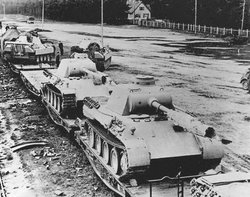
Two major special operations were planned for the offensive. By October it was decided that Otto Skorzeny, the German commando who had rescued Benito Mussolini, was to lead a task force of English-speaking German soldiers in Operation Greif. These soldiers were to be dressed in American and British uniforms and wear dog-tags taken from corpses and POWs. Their job was to go behind American lines and change sign-posts, misdirect traffic, generally cause disruption and to seize bridges across the Meuse River between Liège and Namur. By late November another ambitious special operation was added; Colonel Friedrich August von der Heydte was to lead a Fallschirmjäger (paratrooper) Kampfgruppe in Operation Stösser a nighttime paratroop drop behind the Allied lines aimed at capturing a vital road junction near Malmedy.
German intelligence had set December 20 as the expected date for the start of the upcoming Soviet offensive, aimed at crushing what was left of German resistance on the Eastern Front and thereby opening the way to Berlin. It was hoped that Stalin would delay the start of the operation once the German assault in the Ardennes had begun and wait for the outcome before continuing.
In the final stage of preparations, Hitler and his staff left their Wolf's Lair headquarters in East Prussia, in which they had co-ordinated much of the fighting on the Eastern Front. After a brief visit to Berlin, on December 11, they came to the Eagle's Nest, Hitler's headquarters in southern Germany, the site from which he had overseen the successful 1940 campaign against France and the low countries.
Initial German assault
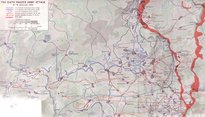
Battle_of_the_Bulge_5th.jpg
Battle_of_the_Bulge_7th.jpg
The German assault began on December 16, 1944 at 0530 hrs with a massive artillery barrage on the Allied troops facing the 6th SS Panzer Army. By 0800 all three German armies attacked through the Ardennes. In the northern sector Dietrich's 6th SS Panzer Army assaulted Losheim Gap and the Elsenborn Ridge in an effort to break through to Liège. In the centre, von Manteuffel's 5th Panzer Army attacked towards Bastogne and St. Vith, both road junctions of great strategic importance. And in the south Brandenberger's 7th Army pushed towards Luxembourg in their efforts to secure the flank from Allied attacks.
Mimicking tactics the Russians had used against German lines with devastating results during Operation Bagration, the German first wave consisted mostly of infantry, who cleared the way and created pincers in the front that could be exploited by Armored troops. The initial advance caught the Americans by surprise and many forward deployed units surrendered, but strong resistance further back greatly slowed the German advance.
Attacks by the 6th SS Panzer Army infantry units in the north fared badly due to unexpectedly fierce resistance by the U.S. 2nd Infantry Division and U.S. 99th Infantry Division, which was attached to the 2nd, at the Elsborn Ridge, stalling their advance; this forced Dietrich to unleash his Panzer forces early. However, starting on December 16, terrible snowstorms engulfed the Ardennes area. While having the desired effect of keeping the Allied aircraft grounded, the weather also proved troublesome for the Germans as poor road conditions hampered their advance, thousands of vehicles got bogged down in massive traffic jams.
In the center and the south, the Germans fared better as they attacked the U.S. 106th Infantry Division. All along the lines, however, the inexperience of some of the German troops was evident. They tended to attack from the open, and marched without cover, making them prime targets for American ambush. The recent Allied development of proximity-fused artillery shells took a heavy toll on troops out in the open.
Hitler had predicted it would take Eisenhower two or three days to realize that the fighting in the Ardennes was a major offensive and not a local counter-attack. His prediction was proven quite wrong; before the first day was finished, Eisenhower—ignoring the advice of his staff—had ordered vast reinforcements to the area. The Red Ball Express stopped delivering supplies and started moving troops. Within a week, 250,000 troops had been sent. At the same time, the 101st Airborne Division, (along with a combat team from the U.S. 10th Armored Division) was ordered to move and defend the town of Bastogne. (Citizen Soldiers, p 201).
Operation Stösser
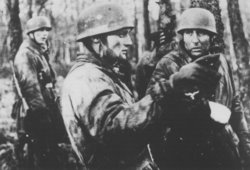
- Main article: Operation Stösser
Originally slated for the early hours of December 16, because of bad weather and fuel shortages Operation Stösser was delayed for a day with the new drop-time being set at 0300 hrs on December 17, their drop-zone was 11 km north of Malmedy and their target was the "Baraque Michel" crossroads. Von der Heydte and his men were to take it and hold it for approximately twenty-four hours until being relieved by the 12th SS Panzer Division Hitlerjugend, thereby hampering the Allied flow of reinforcements and supplies into the area.
Just after the midnight of December 16/17, 112 Ju 52 transport planes with around 1300 Fallschirmjäger (German paratroopers) on board, took off amid a powerful snowstorm, with strong winds and extensive low cloud cover. As a result, many planes went off-course, and men were dropped as far as a dozen kilometers away from the intended drop-zone with only a fraction of the force landing near it. Strong winds also took off-target those paratroopers whose planes were relatively close to the intended drop-zone and made their landings far rougher.
By noon a group of around 300 managed to assemble, but this force was too small and too weak to counter the Allies. Colonel von der Heydte abandoned plans to take the crossroads and instead ordered his men to harass the Allied troops in the vicinity with guerrilla-like actions. Because of the extensive dispersal of the jump, with Fallschirmjäger being reported all over the Ardennes, the Allies believed a major divisional sized jump took place, resulting in much confusion and causing them to allocate men to secure their rear instead of sending them off to the front to face the main German thrust.
Operation Greif
- Main article: Operation Greif
Skorzeny successfully infiltrated his battalion of disguised, English-speaking Germans behind the Allied lines. Although they failed to take the vital bridges over the Meuse, the battalion's presence produced confusion out of all proportion to their military activities, and rumours spread like wild-fire. Even General Patton was alarmed and, on December 17, described the situation to General Eisenhower as "Krauts... speaking perfect English... raising hell, cutting wires, turning road signs around, spooking whole divisions, and shoving a bulge into our defenses".
Checkpoints were soon set up all over the Allied rear, greatly slowing the movement of soldiers and equipment. Military policemen drilled servicemen on things which every American was expected to know, such as the identity of Mickey Mouse's girlfriend, baseball scores, or the capital of Illinois. This latter question resulted in the brief detention of General Omar Bradley himself; although he gave the correct answer—Springfield—the GI who questioned him apparently believed that the capital was Chicago.
Nonetheless, the tightened security made things harder for the German infiltrators, and some of them were captured. Even during interrogation they continued their goal of spreading disinformation; when asked about their mission, some of them claimed they had been told to go to Paris to either kill or capture General Eisenhower. Security around the general was greatly increased, and he was confined to his headquarters. Because these prisoners had been captured in American uniform, they were later executed by firing squad; this was the standard practice of every army at the time, although it was left ambivalent under the Geneva Convention, which merely stated that soldiers had to wear uniforms that distinguished them as combatants. Skorzeny and his men were fully aware of their likely fate, and most wore their German uniforms underneath their Allied ones in case of capture. Skorzeny himself avoided capture and survived the war, leading a colourful life thereafter.
Malmédy massacre
- Main article: Malmédy massacre
In the north, the main armored spearhead of the 6th SS Panzer Army, Kampfgruppe Peiper, consisting of 4800 men and 600 vehicles under the command of Waffen-SS colonel Jochen Peiper, pushed west into Belgium. At 0700 hrs December 17 they seized a US fuel depot at Büllingen where they paused to refuel before continuing westward. At 1230 hrs, near the hamlet of Baugnez, on the height half-way between the town of Malmédy and Ligneuville, they encountered elements of the American 285th Field Artillery Observation Battalion. After a brief battle, the Americans surrendered. They were disarmed and with some other Americans captured earlier (approximately 150 people), sent to stand in a field near the crossroads. A tank pulled up, and a truck shortly thereafter. A single SS officer pulled out a pistol and shot a medical officer standing in the front row, and then shot the man standing next to the medical officer. Other soldiers joined in with machine guns. It is not known why this happened; there is no record of an order by an SS officer — however, such routine shootings of prisoners of war (POWs) were common on the Eastern Front. News of the killings raced through Allied lines. Afterwards, the order went out: SS and Fallschirmjäger were to be shot on sight. Following the war, captured SS soldiers who were part of Kampfgruppe Peiper were tried in the controversial Malmédy Massacre Trial.
The fighting went on, and by the evening, the Leibstandarte had pushed north to engage the U.S. 99th Infantry Division and Kampfgruppe Peiper arrived in front of Stavelot. He was already behind the timetable, as it took 36 hours to advance from Eifel to Stavelot; it had taken just 9 hours in 1940. As the Americans fell back, they blew up bridges and fuel dumps, denying the Germans critically needed fuel, and further slowing their progress.
The assault of Kampfgruppe Peiper
WaffSSPeiper_3-2.jpg
Peiper entered Stavelot on December 18 but encountered fierce resistance by the American defenders. Unable to beat the American force in area, he left a smaller support force in town and with the bulk of his forces headed for the bridge at Trois-Ponts but by the time he reached it, the retreating Allies had already destroyed it. Peiper pulled off and headed for the village of La Gleize and from then on to Stoumont. There, as Peiper approached, the American engineers blew up the bridge and the American troops were entrenched and ready to fight a bitter battle.
His troops were cut off from the main German force and supplies when the Americans recaptured the poorly defended Stavelot on December 19. As their situation in Stoumont was becoming hopeless, Peiper decided to pull back to La Gleize where he set up his defenses waiting for the German relief force. As no relief force was able to penetrate Allied defenses, on December 23 Peiper decided to break through back to the German lines. The men of the Kampfgruppe were forced to abandon their vehicles and heavy equipment although the vast majority of the unit was able to escape.
St. Vith
- Main article: Battle of St. Vith
In the centre, the town of St. Vith, a vital road junction, presented the main challenge for both von Manteuffel's and Dietrich's force. The defenders, led by the U.S. 7th Armored Division, and also including the U.S. 106th Infantry Division, and additional elements of the U.S. 9th Armored Division and U.S. 28th Infantry Division, all under the command of General Bruce C. Clarke, successfully resisted the German attacks, thereby significantly slowing the German advance. The Germans managed to capture St. Vith on December 21, but U.S. troops fell back to entrenched positions in the area, presenting an imposing obstacle to a successful German advance. By December 23, as the Germans shattered their flanks, the defenders' position became untenable and U.S. troops were ordered to retreat west of the Salm River. As the German plan called for the capture of St. Vith by 1800 hrs December 17, the prolonged action in and around it presented a major blow to their timetable.
Bastogne
On December 19, the senior Allied commanders met in a bunker in Verdun. Eisenhower, realizing that the Allies could destroy German forces much more easily when they were out in the open and on the offensive than if they were on the defensive, told the generals "The present situation is to be regarded as one of opportunity for us and not of disaster. There will be only cheerful faces at this table". Patton, realizing what Eisenhower implied, responded "Hell, let's have the guts to let the bastards go all the way to Paris. Then, we'll really cut'em off and chew'em up". Eisenhower asked Patton how long it would take to turn his Third Army (then located in south-central France) north to counter-attack. He said he could do it in 48 hours, to the disbelief of the other generals present. In fact, before he had gone to the meeting, Patton had ordered his staff to prepare to turn north; by the time Eisenhower asked him how long it would take, it was already part-way done. (Citizen Soldiers, p 208)
By December 21, the German forces had completely surrounded Bastogne, which was defended by the 101st Airborne Division and Combat Command B of the 10th Armoured Division. Conditions inside the perimeter were tough—most of the medical supplies and personnel had been captured. However, despite determined German attacks, the perimeter held. When General Anthony McAuliffe was awakened by a German invitation to surrender, he gave a one-syllable reply that has been variously reported and was probably unprintable. However, there is no disagreement as to what he wrote on the paper delivered to the Germans: "NUTS!" (Some source spell it "NUTZ") That reply had to be explained, both to the Germans and to non-American Allies.2
Rather than launching one simultaneous attack all around the perimeter, the German forces concentrated their assaults on several individual locations attacked in sequence. Although this compelled the defenders to constantly shift reinforcements in order to repel each attack, it tended to dissipate the Germans' numerical advantage.
Allied counteroffensive
On December 23 the weather conditions started improving, allowing the Allied air forces to attack. They launched devastating bombing attacks on the German supply points in their rear and P-47s started decimating the German troops on the roads. The Allied air forces also helped the defenders of Bastogne, dropping much needed supplies—medicine, food, blankets and ammunition. A team of volunteer surgeons flew in by glider and began operating in a tool room.
By December 24, the German advance was effectively stalled short of the Meuse River. They had outrun their supply lines and shortages of fuel and ammunition were becoming critical. Up to this point the German losses had been light, notably in terms of armor which was almost untouched with the exception of Peiper's losses. On the evening of the 24th, General Hasso von Manteuffel recommended to Hitler's Military Adjutant a halt to all offensive operations and a withdrawal back to the West Wall. Hitler rejected it.
Patton's Third Army was now battling to relieve Bastogne. At 1650 on December 26, the lead element of the Fourth Armored Division reached Bastogne, ending the siege.
- Charles Boggess drove the first vehicle from the 4th Armored into the lines of the 101st Airborne. He was followed by Capt. William Dwight. 'How are you, General?' Dwight asked General McAuliffe, who had driven out to the perimeter to greet them. 'Gee, I'm mighty glad to see you', McAuliffe replied'. (Citizen Soldiers, p 248).
Germans strike back
On January 1, in an attempt to keep the offensive going, the Germans launched two new operations. At 0915 the Luftwaffe launched Operation Bodenplatte, a major campaign against Allied airfields in the Low Countries. Hundreds of planes attacked Allied airfields, destroying or severely damaging some 465 aircraft. However, the Luftwaffe lost 277 planes, 62 to Allied fighters and 172 mostly because of an unexpectedly high number of Allied flak guns, set up to protect against German V-1 flying bomb attacks, but also due to friendly fire from the German flak guns that were uninformed of the pending large scale German air operation. While the Allies recovered from their losses in just days, the operation left the Luftwaffe "weaker than ever and incapable of mounting any major attack again". (A World At Arms, p 769, Gerhard Weinberg).
On that same day, Operation Nordwind, a diversionary attack into the Alsace region, began. The fighting ranged over 150 kilometers from Saarbrucken in the north to the Rhine in the South. After twenty gruelling days of fighting, the Americans fell back, having taken some 11,609 casualties but inflicting 23,000.
Allies prevail
While the German offensive had ground to a halt, they still controlled a dangerous salient in the Allied line, from which their panzers could wreak havoc. The Allied counter-attack was slated to begin on January 1. Patton's Third Army in the south, centered around Bastogne, would attack north, Montgomery's forces in the north would strike south. The two forces would meet up at Houffalize.
Many of the men slated to attack were incredulous — they could not believe that after two weeks of heavy fighting, they were being asked to spearhead another major offensive. Not only was exhaustion a factor, but the temperature during January 1945 was the coldest on record; trucks had to be run every half hour, or the oil in them would freeze; weapons would freeze, and so men took to urinating on them to warm them up. Men typically wore multiple overcoats and slept with two to four blankets. The offensive went forward notwithstanding morale.
P41(map).jpg
Eisenhower had put American troops in the north (the 1st and 9th American Armies), under Montgomery's British 21st Army Group command. Eisenhower wanted Montgomery to go on the offensive on January 1, with the aim of meeting up with Patton's advancing Third Army and cutting off most of the attacking Germans, trapping them in a pocket. However refusing to commit men he considered underprepared in a snowstorm, Montgomery did not launch the attack until January 3, by which time substantial numbers of German troops had already managed to successfully disengage, albeit with the loss of their heavy equipment. Bradley later protested this assignment vehemently, describing Montgomery as "all-out, right-down-to-the-toes mad", and refusing to serve under him.
At the start of the offensive, the two Armies were separated by about 40 kilometers. American progress in the south was also slow — about a kilometer a day. The Germans performed a fighting retreat, doing their best to delay the Americans. The majority of the German force escaped the battle, although the fuel situation had become so dire that most of the German armor had to be abandoned.
On January 7, 1945, Hitler agreed to pull back most of the forces from the Ardennes, including the elite SS Panzer Divisions, thus ending all offensive operations. The Ardennes Offensive was now over, leaving the Allies to mop up the remaining German stragglers.
On the same day Montgomery held a press conference at Zonhoven in which he gave credit for the victory to the "courage and good fighting quality" of the American troops, characterizing a typical American as a "very brave fighting man who has that tenacity in battle which makes a great soldier". He went on to talk about the neccesity of Allied teamwork, and praise Eisenhower, stating that "Teamwork wins battles and battle victories win wars. On our team the captain is General Ike." Some of his comments, particularly his noting that when the situation "began to deteriorate", Eisenhower placed him in command of the north, were inflammatory to Patton. The comments implied that the situation worsened under his leadership, until he was rescued by Montgomery "with a bang". In the context of Patton and Montgomery's well known mutual loathing, the phrasing of the comment can only be seen as malicious. Montgomery entirely failed to mention the contibution of the American generals beside Eisenhower to the victory, focusing exclusively on his own generalship. In the press conference Montgomery said that he thought the counter-offensive had gone very well, he did not explain the reason for his delayed attack on January 3 at the time, but later attributed this to needing more time for preparation on the northern front. According to Churchill, the attack from the south under Patton was steady but slow and involved heavy losses, and Montgomery claimed to be trying to avoid this situation.
Bradley and Patton both threatened to resign unless Montgomery's command was changed. Subsequently Bradley started to court the press, and it was stated that he would rarely leave headquaters "without at least fifteen newspapermen"; it has been suggested that he and Patton began to leak information detrimental to Montgomery.
Although the German advance was halted, the overall situation remained dangerous. On January 6 Winston Churchill once again asked Stalin for support. On January 12, the Red Army launched the Vistula-Oder Offensive in Poland and East Prussia. Soviet sources claim this was done ahead of schedule, while most Western sources doubt it, and instead claim the Soviet Offensive was delayed because of the situation in the West, with Stalin waiting out until both sides had militarily exhausted themselves.
The Battle of the Bulge ended when the two American forces met up on January 15, 1945.
Aftermath
Battle_of_the_bulge_memorial.jpg
Casualty estimates from the battle vary widely. American casualties are given variously as 70,000 to 81,000 (approximately), British as 1,400; German casualties are estimated at between 60,000 and 104,000.
The Allies pressed their advantage following the battle. By the beginning of February 1945, the lines were roughly where they had been in December 1944. In early February, the Allies launched an attack all along the Western front: in the north under Montgomery toward Aachen; in the center, under Courtney Hodges; and in the south, under Patton. Montgomery's behavior during the months of December and January, including holding a press conference on January 7th where he downplayed the contribution of the American generals, soured his relationship with his American counterparts through to the end of the war.
The German losses in the battle were critical in several respects: the last of the German reserves were now gone; the Luftwaffe had been broken; and the German army in the West was being pushed back. Most importantly, the Eastern Front was now ripe for the taking. In the East, the German army was unable to halt the Soviet juggernaut. German forces were sent reeling on two fronts and never recovered.
The battle in popular culture
The Battle of the Bulge has been the setting of several movies and novels. A full length movie, Battle of the Bulge was made in 1965, starring Henry Fonda. (IMDB entry (http://www.imdb.com/title/tt0058947/)) However it is infamous for countless major inaccuracies.
Stephen Ambrose's Band of Brothers is a factual account which follows the fortunes of Easy Company, 506th Parachute Infantry Regiment, 101st Airborne. It was later made into a BBC/HBO television series, also called Band of Brothers, that includes the Company's experiences in the Battle of the Bulge, particularly near Bastogne. Episode 6 of the television series, titled "Bastogne", depicts the fighting around Bastogne during the Battle of the Bulge.
Battleground is a 1949 film depicting the 101st Airborne's defense of Bastogne.
The video game Battlefield 1942 allows you to re-enact the battle, as does Call of Duty: United Offensive, but the games focus too much on just Bastogne to be considered a full reenactment. Close Combat IV: Battle of the Bulge (1999 by SSI) is seen by many as the most accurate implementation of the full battle.
The award-winning WWII-themed board game Memoir '44 also contains a scenario that reenacts the battle.A number3 of other board games deal with this battle in various degrees of complexity, but in greater detail than Memoir '44.
Footnotes
¹ This offensive has several other names, including Operation Nordwind by Nazi Germany, the erroneous Von Rundstedt Offensive (in reality von Rundstedt had little to do with it) and, officially to the U.S. Army, as the Ardennes-Alsace Campaign.
² Nuts('Nutz') can mean a number of things in American English, depending on the context. Aside from the food, 'nuts' most commonly means 'crazy' as in, "What, are you nuts!?". It can also be a slang for testicles, similar to the British English bollocks. In this context, it likely means 'rubbish!' or approximately 'go to hell'.
³ Tigers in the Mist and Ardennes '44 by GMT Games. Bitter Woods by The Avalon Hill Company.
References
- The Last Offensive by Charles MacDonald (ISBN 1568520018)
- Riviera to the Rhine by Jeffrey J. Clarke and Robert Ross Smith (ISBN 0756764866)
- Company Commander by Charles MacDonald (ISBN 1580800386)
- Citizen Soldiers by Stephen Ambrose (ISBN 0684848015)
- The Longest Winter by Alex Kershaw (ISBN 0306813041).
External links
- Battle of the Bulge on the Web (directory) (http://www.isidore-of-seville.com/bulge/)
- The Ardennes: Battle of the Bulge (http://www.army.mil/cmh-pg/books/wwii/7-8/7-8_cont.htm), the official US Army history by Hugh M. Cole
- http://hometown.aol.com/dadswar/bulge/index.htm
- http://ardenne44.free.fr/page2.html
- Canadian War Museum online WW2 newspaper archive (http://www.warmuseum.ca/cwm/newspapers/intro_e.html)
- The German Counteroffensive in the Ardennes (http://www.army.mil/cmh-pg/books/70-7_20.htm)de:Ardennenoffensive
es:Batalla de las Ardenas fr:Bataille des Ardennes it:Offensiva delle Ardenne he:קרב הארדנים ms:Pertempuran Bulge nl:Ardennenoffensief ja:バルジの戦い pl:Ofensywa w Ardenach sv:Ardenneroffensiven wa:Ofinsive da Von Rundstedt


